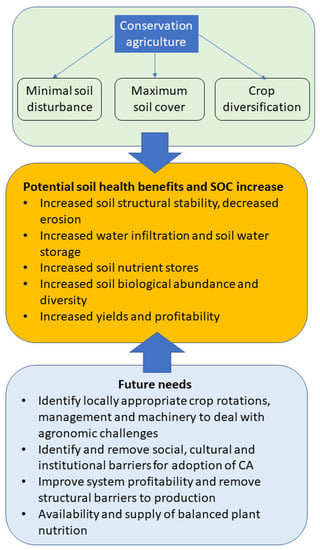Intensive agriculture causes land degradation and other environmental problems, such as pollution, soil erosion, fertility loss, biodiversity decline, and greenhouse gas (GHG) emissions, which exacerbate climate change. Sustainable agricultural practices, such as reduced tillage, growing cover crops, and implementing crop residue retention measures, have been proposed as cost-effective solutions that can address land degradation, food security, and climate change mitigation and adaptation by enhancing soil organic carbon (SOC) sequestration in soils and its associated co-benefits. In this regard, extensive research has demonstrated that conservation agriculture (CA) improves soil physical, chemical, and biological properties that are crucial for maintaining soil health and increasing agroecosystem resilience to global change.
1. Background and Rationale
The concept of conservation agriculture (CA) was born in the 1930s when Edward Faulkner first questioned the utility of ploughing in a manuscript called
Ploughman’s Folly, and it gained popularity during the 1960s in the mid-western United States as a means of preventing soil degradation after the Dust Bowl ecological disaster that occurred in the 1930s. Since then, research on adapting CA practices to cropping systems has been undertaken worldwide. In addition to reducing tillage intensity, CA also implies the application of organic amendments, such as manure, compost, and by-products from agro-industry
[1], and the improvement of N management if mineral fertilizers are adopted to decrease N
2O emissions
[2].
The exploitation of agricultural soils based on crop monocultures and deep tillage with inversion of the layers has resulted in progressive soil structure degradation and compaction and reductions in soil organic matter content. These detrimental developments have triggered negative cascade effects on the soil biota and fertility, increasing soil water and wind erosion and CO
2 emissions
[3][4][3,4]. Among alternative management systems to conventional agriculture that aim at the sustainability of crop systems, CA represents one of the most advanced models.
2. Adoption of Conservation Agriculture (CA)
CA is defined by the Food and Agriculture Organization
[5][6][5,6] as “a sustainable agricultural production system for the protection of water and agricultural soil that integrates agronomic, environmental and economic aspects”. CA is based on three principles (
Figure 1): minimum mechanical soil disturbance through conservation tillage (i.e., no tillage, minimum tillage), permanent soil organic cover with crop residues and/or cover crops, and crop diversification through rotations and associations involving at least three different crops (including a legume crop). The benefits of CA are shown in
Table 1.
Figure 1.
Principles of conservation agriculture, benefits of increasing SOC, and future needs. Modified from [7].
Kassam et al.
[8] analysed the spread of the adoption of CA in 2015–2016 in different countries based on data available from government statistics, no-till farmer organizations, ministries of agriculture, non-governmental organizations, and research and development organizations.
The highest cropland areas were in South and North America (Table 2), with 69.9 and 63.2 M ha of cropland areas employed for CA, representing 38.7 and 35.0% of the total cropland employed for CA, respectively. However, CA represented 63.2% of the cropland area in South America and 28.1% in North America. The corresponding values for Australia/New Zealand and Asia were 22.7 and 13.9 M ha (12.6 and 7.7% of total cropland), representing 45.4 and 4.1% of croplands in the respective regions. Cropland areas employed for CA decreased in the order Russia/Ukraine > Europe > Africa from 5.7 to 1.5 M ha; i.e., from 3.6 to 1.1% of these regions’ total cropland areas, respectively. Globally, the total cropland area employed for CA was 180.4 M ha, equivalent to 12.5% of total cropland.
Table 1.
Benefits of conservation agriculture [9].
Table 2. Cropland areas employed for CA by region in 2015–16, CA area as percentage of global total cropland, and CA area as percentage of cropland of each region
[8].

